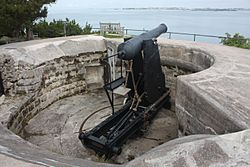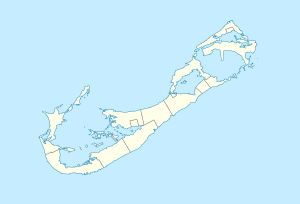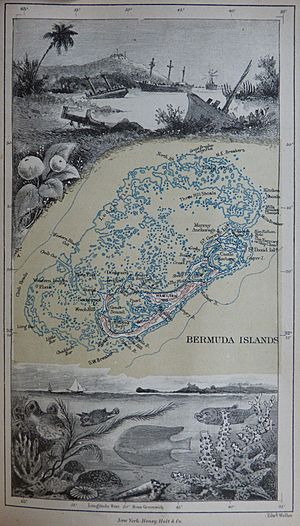Scaur Hill Fort, Bermuda facts for kids
Quick facts for kids Scaur Hill Fort |
|
|---|---|
| Scaur Hill, Somerset Island, Sandys Parish, Bermuda | |

A 64 Pounder Rifled Muzzle-Loader (RML) gun on Moncrieff disappearing mount, at Scaur Hill Fort
|
|
| Coordinates | 32°17′07″N 64°52′20″W / 32.285168°N 64.872304°W |
| Type | Fort |
| Site information | |
| Owner | War Office (original) Parks Department of the local Government of Bermuda (current) |
| Operator | |
| Open to the public |
Yes |
| Condition | Under ongoing restoration |
| Site history | |
| Built | 1870s |
| In use | 1870s - 1957 |
| Materials | Stone |
| Garrison information | |
| Garrison | Bermuda Garrison Western District |
| Occupants | Royal Artillery, Royal Engineers, United States Army Coast Artillery Corps |
Scaur Hill Fort, also known as Scaur Hill Lines, is an old military fort built in the 1870s. It sits on Scaur Hill, located on Somerset Island in Sandys Parish, which is the western part of Bermuda. This fort was an important part of Bermuda's defenses, helping to protect the island as a key military base for the British Empire.
Contents
Why Scaur Hill Fort Was Built
Bermuda was a very important place for the British Navy and Army. It was a central base in the western Atlantic Ocean. Because of this, a lot of money was spent in the 1800s to protect the island from attacks.
Many forts and gun batteries were built or updated around Bermuda. Most of the biggest guns were placed at the East End of the island. This was because the main shipping channel, where large ships could enter Bermuda's harbors, was located there.
However, there were also smaller channels at the West End. These were mostly used by fishing boats. During the American War of Independence, an event called the Battle of Wreck Hill happened here. Rebel ships tried to enter through a channel called the Hogfish Cut. The existing fort at Wreck Hill managed to stop them. But the rebels landed soldiers who attacked the fort from behind, showing a weakness in the defenses.
Later, fast attack boats called torpedo boats became a new threat. These small, speedy boats could cause a lot of damage to naval ships anchored in the nearby Great Sound. To protect against this, new defenses were needed at the West End.
Another concern was that enemy soldiers might land on the South Shore and march overland to the West End.
The Moat and Guns
To stop land attacks, a large, dry ditch, or moat, was dug across Somerset Island. This moat went through Scaur Hill, connecting Ely's Harbour to the Great Sound. Soldiers could defend this line with small guns from behind its walls.
The fort also had powerful artillery support. It featured two 64 Pounder Rifled Muzzle-Loader (RML) guns. These guns were placed on special "disappearing mounts" called Moncrieff mounts. A disappearing mount allowed the gun to pop up to fire, then drop back down behind a wall for protection.
One of these guns was in a small, strong building called a keep. This gun could turn all the way around (360 degrees). The other gun was in a separate spot nearby. These guns could fire up to 4,000 yards. This meant they could hit enemy soldiers coming from the Main Island or ships trying to get through the western channels.
The keep for the eastern gun was built in a Prussian style, which means it had many sides. It had a strong wall and a dry moat behind it, protected by a blockhouse. Like many forts in Bermuda, Scaur Hill Fort was hard to see from the water because it was built into the landscape.
Scaur Hill Fort in the 20th Century
By the time of the First World War, the muzzle-loading guns at Scaur Hill Fort were old-fashioned. The fort was then used as a place where mobile field guns could be set up if needed. It also served as a training area for soldiers.
After the First World War, the British Army in Bermuda was greatly reduced. Many regular soldiers were sent home. By 1928, the Royal Artillery and Royal Engineers units were removed. Local part-time soldiers became responsible for maintaining the defenses.
World War II Changes
At the start of the Second World War, the British government couldn't afford to improve Bermuda's defenses much. Instead, they allowed the United States to build new military bases on the island. This happened even before the U.S. entered the war.
The U.S. Army's United States Army Coast Artillery Corps set up many new guns around Bermuda. At Scaur Hill, they placed two large 8-inch railway guns. These were located just north of the fort's water collection area. The U.S. Army also built observation towers across Bermuda to help coordinate the firing of all the guns.
After the Second World War, most American military forces left Bermuda. The British Army also continued to reduce its presence. By 1957, all regular British Army units were withdrawn from Bermuda. The land and forts, including Scaur Hill, were then given to the local government in 1958.
Scaur Hill Fort Today
Today, the Government of Bermuda manages Scaur Hill Fort as a public park. Visitors can explore the old fortifications and enjoy the natural surroundings.
Some parts of the original disappearing gun mounts are still at the fort, even though the guns themselves were removed long ago. However, one of the eastern gun positions now has a rebuilt mount with an original gun. Parts for a second gun are being put together for the western position.



